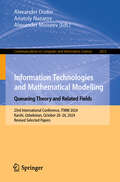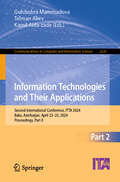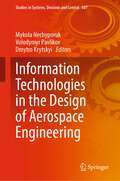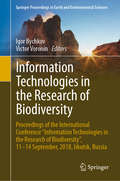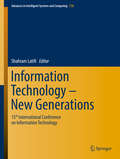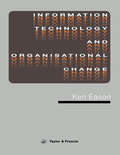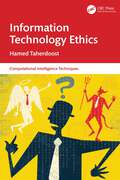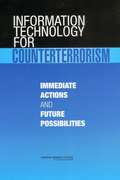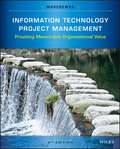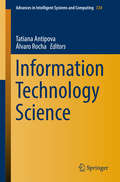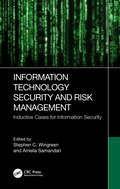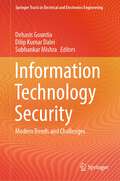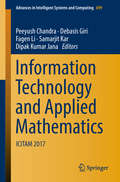- Table View
- List View
Information Technologies and Mathematical Modelling. Queueing Theory and Related Fields: 23rd International Conference, ITMM 2024, Karshi, Uzbekistan, October 20–26, 2024, Revised Selected Papers (Communications in Computer and Information Science #2472)
by Alexander Dudin Anatoly Nazarov Alexander MoiseevThis book constitutes the refereed proceedings of the 23rd International Conference on Information Technologies and Mathematical Modelling. Queueing Theory and Related Fields, ITMM 2024, held in Karshi, Uzbekistan, during October 20–26, 2024. The 26 full papers included in this book were carefully reviewed and selected from 136 submissions. The papers are devoted to new results in queueing theory and its applications, and also related areas of probabilistic analysis. Its target audience includes specialists in probabilistic theory, random processes, and mathematical modeling as well as engineers engaged in logical and technical design and operational management of data processing systems, communication, and computer networks.
Information Technologies and Their Applications: Second International Conference, ITTA 2024, Baku, Azerbaijan, April 23–25, 2024, Proceedings, Part I (Communications in Computer and Information Science #2225)
by Telman Aliev Gulchohra Mammadova Kamil Aida-ZadeThe two-volume set CCIS 2225 and 2226 constitutes the proceedings of the Second International Conference on Information Technologies and Their Applications, ITTA 2024, held in Baku, Azerbaijan, during April 23-25, 2024. The 51 full papers and 9 short papers presented were carefully reviewed and selected from 200 submissions. They were organized in the following topical sections: Part I - information technology in intelligent systems; and information technology in modeling. Part II - information technology applied in construction, industry, and engineering; and information technology in decision making.
Information Technologies and Their Applications: Second International Conference, ITTA 2024, Baku, Azerbaijan, April 23–25, 2024, Proceedings, Part II (Communications in Computer and Information Science #2226)
by Telman Aliev Gulchohra Mammadova Kamil Aida-ZadeThe two-volume set CCIS 2225 and 2226 constitutes the proceedings of the Second International Conference on Information Technologies and Their Applications, ITTA 2024, held in Baku, Azerbaijan, during April 23-25, 2024. The 51 full papers and 9 short papers presented were carefully reviewed and selected from 200 submissions. They were organized in the following topical sections: Part I - information technology in intelligent systems; and information technology in modeling. Part II - information technology applied in construction, industry, and engineering; and information technology in decision making.
Information Technologies in the Design of Aerospace Engineering (Studies in Systems, Decision and Control #507)
by Mykola Nechyporuk Volodymyr Pavlikov Dmytro KrytskyiThis book proposes a solution to the problem of incorrect use of automation tools to perform complex design work. Currently, a large number of start-up projects are non-professional design bureaus that show a huge amount of their achievements. In reality, most of these achievements burst like soap bubbles. This is due to the low-quality and inefficient use of information technology in this industry. The book highlights advanced information technologies in the fields of design, machine learning, and computer vision.
Information Technologies in the Research of Biodiversity: Proceedings of the International Conference "Information Technologies in the Research of Biodiversity", 11–14 September, 2018, Irkutsk, Russia (Springer Proceedings in Earth and Environmental Sciences)
by Igor Bychkov Victor VoroninThis book offers a collection of papers presented at the First International Conference” Information Technologies in the Research of Biodiversity” that was held from 11-14 September 2018 in Irkutsk (Russia). Papers in this book cover areas of interaction of knowledge on biodiversity and information technologies. The main topics include: methods, models, software systems for the analysis of biodiversity data; global data portals; information and analytical systems on biodiversity; application of remote methods in vegetation mapping; theoretical fundaments and organization technologies of the information and telecommunications infrastructures.
Information Technologies: Teaching to Use—Using to Teach
by Leon Ginsberg Frank B Raymond Iii Debra GohaganThis insightful volume explores examples of the use of technology to teach social work knowledge, values, and skills across the curriculum. The chapters cover a wide range of perspectives, including international views of the role of information technology in Great Britain and Malaysia, training approaches for faculty development, and computer-based software that has the potential to transform the manner in which curriculum objectives are met. Prepare for technology-based instruction in social work education for the 21st century!Information Technologies: Teaching to Use--Using to Teach Information Technologies: Teaching to Use--Using to Teach, addresses your need to fully prepare today?s social work graduates to work and live in this rapidly changing, technology-enhanced environment. Based on the 1997 Information Technologies Conference: Using to Teach--Teaching to Use, held in Charleston, South Carolina, this book covers the multitude of topics that were presented on technology-based instruction as we head into the 21st century. Articles in Information Technologies range from the use of the Internet and computer applications to research projects that address the effectiveness of technology-based teaching and learning activities. It also dicusses international views on the role of information technology in Britian and Malaysia. Information Technologies gives particular attention to distance education, and it is the most thorough treatment to date of the use and teaching of technology in social work education. Specific areas you?ll gain valuable information from include:establishing a faculty development labstarting intensive faculty training sessionscomputer-based software that has the potential to transform the manner in which curriculum objectives are metinternational perspectives on information technologythe use of Geographic Information Systems technology in social work practice as a tool for improved visualization of social and economic inequalitiesmodels for teaching social work curriculum with technologyWith Information Technologies, you will gain a competetive edge in preparing your faculty and students with the latest world-wide information on studies pretaining to technology use in a social work setting. A conglomeration of diverse and well-researched articles on the use of technology to enhance social work education await you in this special volume.
Information Technology (IT)-Based Educational Materials: Workshop Report with Recommendations
by Committee on Achieving Compatibility in IT-Based Educational MaterialsIn the last half-century, we have witnessed the birth and development of a new era: the information age. Information Technology (IT), the primary vehicle of the information age, has transformed the modern workplace and is pervasive in the development of new knowledge and wealth. IT has also dramatically influenced our capacity to educate. Yet, the application of IT in education has been disorganized and uneven. Pockets of innovation in localized environments are thriving, but the promise of open access, greatly enhanced teaching and learning, and large-scale use has not been realized. IT-Based Educational Materials: Workshop Report with Recommendations identifies critical components that support the development and use of IT-based educational materials. The report points to three high priority action areas that would produce a transitional strategy from our fragmented environment to an IT-transformed future in engineering education--Build Community; Create Organizational Enablers; and Coordinate Action. The report outlines six recommendations, including a call to establish a national laboratory to carry out evidenced-based investigations and other activities to insure interoperability and effective teaching and learning. The report stresses the need to pursue open architectures and to engage multidisciplinary researchers, including social scientists and others who address the transformation of faculty cultures. The report also discusses the need to engage users and developers of the IT-products in activities that are driven by student learning outcomes.
Information Technology - New Generations
by Shahram LatifiThis volume presents a collection of peer-reviewed, scientific articles from the 14th International Conference on Information Technology - New Generations, held at the University of Nevada at Las Vegas on April 10-12, at Tuscany Suites Hotel in Las Vegas. The Book of Chapters addresses critical areas of information technology including web technology, communications, computing architectures, software engineering, security, and data mining.
Information Technology - New Generations: 14th International Conference On Information Technology (Advances In Intelligent Systems And Computing #558)
by Shahram LatifiThis volume presents a collection of peer-reviewed, scientific articles from the 15th International Conference on Information Technology – New Generations, held at Las Vegas. The collection addresses critical areas of Machine Learning, Networking and Wireless Communications, Cybersecurity, Data Mining, Software Engineering, High Performance Computing Architectures, Computer Vision, Health, Bioinformatics, and Education.
Information Technology And Organisational Change
by K.D. EasonFirst published in 1988. Information Technology is a prowerful force for organisational change, but its implementation can cause major difficulties and is often obstructed as people do not know how to cope with it. Written from 18 years of practical experience, this book is designed to help managers, users and technical specialists appreciate the human and organisational implications of information technology, and provide practical guidance on managing these issues which are crucial to the successful exploitation of the technology. This is not a book to teach people about information technology; rather it is about what to use it for and how to harness its potential.
Information Technology Control and Audit, Fifth Edition
by Angel R. OteroThe new fifth edition of Information Technology Control and Audit has been significantly revised to include a comprehensive overview of the IT environment, including revolutionizing technologies, legislation, audit process, governance, strategy, and outsourcing, among others. This new edition also outlines common IT audit risks, procedures, and involvement associated with major IT audit areas. It further provides cases featuring practical IT audit scenarios, as well as sample documentation to design and perform actual IT audit work. Filled with up-to-date audit concepts, tools, techniques, and references for further reading, this revised edition promotes the mastery of concepts, as well as the effective implementation and assessment of IT controls by organizations and auditors.
Information Technology Convergence: Security, Robotics, Automations and Communication
by Fatos Xhafa James J. Park Hwa Young Jeong Leonard BarolliInformation technology and its convergence issue is emerging rapidly as an exciting new paradigm with user-centric environment to provide computing and communication services. This area will be the most comprehensive topics with various aspects of advances in information technology and its convergence services. This book covers all topics as computational science and applications, electronics engineering, manufacturing technology, services, technical skill to control the robot, automatic operation and application, simulation and testing communication and many more.
Information Technology Convergence: Security, Robotics, Automations and Communication (Lecture Notes in Electrical Engineering #253)
by Fatos Xhafa James J. Jong Hyuk Park Hwa Young Jeong Leonard BarolliInformation technology and its convergence issue is emerging rapidly as an exciting new paradigm with user-centric environment to provide computing and communication services. This area will be the most comprehensive topics with various aspects of advances in information technology and its convergence services. This book covers all topics as computational science and applications, electronics engineering, manufacturing technology, services, technical skill to control the robot, automatic operation and application, simulation and testing communication and many more.
Information Technology Ethics (Computational Intelligence Techniques)
by Hamed TaherdoostThis book explains moral dilemmas in the IT industry, focusing on a different area of IT ethics. It starts by introducing theories, decision-making models, and the fundamental function of moral leadership in IT companies, followed by ethical obligations related to intellectual property, privacy, professional ethics, and software development. It looks at how IT affects society in terms of accessibility and well-being, including cybersecurity tactics, privacy and data protection legislation, legal and regulatory frameworks, and the moral obligations of IT workers and companies.Features: Includes extensive examination of IT ethics encompassing fundamental theories Covers foundational concepts, intricate ethical quandaries, and societal ramifications Provides practical guidance with real-world illustrations, case studies, and optimal approaches Integrates cultural perspectives, case studies, and discussions on worldwide legal frameworks, accessibility challenges, and environmental sustainability Reviews the Canadian perspective on IT ethics, exploring the specific legal and ethical landscape of the country This book is aimed at senior undergraduate and graduate students in computer engineering and IT, as well as professionals.
Information Technology For Counterterrorism: Immediate Actions And Future Possibilities
by Committee on the Role of Information Technology in Responding to TerrorismInformation technology (IT) is essential to virtually all of the nation's critical infrastructures making them vulnerable by a terrorist attack on their IT system. An attack could be on the system itself or use the IT system to launch or exacerbate another type of attack. IT can also be used as a counterterrorism tool. The report concludes that the most devastating consequences of a terrorist attack would occur if it were on an IT system or used one as part of a broader attack. The report presents two recommendations on what can be done in the short term to protect the nation's communications and information systems and several recommendations about what can be done over the longer term. The report also notes the importance of considering how an IT system will be deployed to maximize protection against and usefulness in responding to attacks.
Information Technology Governance in Public Organizations
by Gianluigi Viscusi Lazar RusuThis book examines trends and challenges in research on IT governance in public organizations, reporting innovative research and new insights in the theories, models and practices within the area. As we noticed, IT governance plays an important role in generating value from organization's IT investments. However there are different challenges for researchers in studying IT governance in public organizations due to the differences between political, administrative, and practices in these organizations. The first section of the book looks at Management issues, including an introduction to IT governance in public organizations; a systematic review of IT alignment research in public organizations; the role of middle managers in aligning strategy and IT in public service organizations; and an analysis of alignment and governance with regard to IT-related policy decisions. The second section examines Modelling, including a consideration of the challenges faced by public administration; a discussion of a framework for IT governance implementation suitable to improve alignment and communication between stakeholders of IT services; the design and implementation of IT architecture; and the adoption of enterprise architecture in public organizations. Finally, section three presents Case Studies, including IT governance in the context of e-government strategy implementation in the Caribbean; the relationship of IT organizational structure and IT governance performance in the IT department of a public research and education organization in a developing country; the relationship between organizational ambidexterity and IT governance through a study of the Swedish Tax Authorities; and the role of institutional logics in IT project activities and interactions in a large Swedish hospital.
Information Technology Project Management: Providing Measurable Organizational Value
by Jack MarchewkaThe 5th Edition of Jack Marchewka's Information Technology Project Management focuses on how to create measurable organizational value (MOV) through IT projects. The author uses the concept of MOV, combined with his own research, to create a solid foundation for making decisions throughout the project's lifecycle. <p><p> The book's integration of project management and IT concepts provides students with the tools and techniques they need to develop in this field.
Information Technology Risk Management in Enterprise Environments
by Jake Kouns Daniel MinoliDiscusses all types of corporate risks and practical means of defending against them.Security is currently identified as a critical area of Information Technology management by a majority of government, commercial, and industrial organizations.Offers an effective risk management program, which is the most critical function of an information security program.
Information Technology Science (Advances In Intelligent Systems And Computing #724)
by Álvaro Rocha Tatiana AntipovaThis book includes a selection of articles from the 2017 International Conference on Information Technology Science (MosITS’17), held on December 1-3, 2017, at the Izmailovo Convention Centre, Moscow, Russia.MosITS’17 was an international forum for researchers and practitioners to present and discuss the most recent innovations, trends, results, experiences and concerns in various areas of information technology science.The papers cover topics such as information technology in communication, management science, public administration, economics, business & finance, history, health & rehabilitation, education, and in architecture.
Information Technology Security and Risk Management: Inductive Cases for Information Security
by Stephen C. Wingreen Amelia SamandariInformation Technology Security and Risk Management: Inductive Cases for Information Security is a compilation of cases that examine recent developments and issues that are relevant to IT security managers, risk assessment and management, and the broader topic of IT security in the 21st century. As the title indicates, the cases are written and analyzed inductively, which is to say that the authors allowed the cases to speak for themselves, and lead where they would, rather than approach the cases with presuppositions or assumptions regarding what the case should be "about". In other words, the authors were given broad discretion to interpret a case in the most interesting and relevant manner possible; any given case may be "about" many things, depending on the perspective adopted by the reader, and many different lessons may be learned. The inductive approach of these cases reflects the design philosophy of the advanced IT Security and Risk Management course we teach on the topic here at the University of Canterbury, where all discussions begin with the analysis of a specific case of interest and follow the most interesting and salient aspects of the case in evidence. In our course, the presentation, analysis, and discussion of a case are followed by a brief lecture to address the conceptual, theoretical, and scholarly dimensions arising from the case. The inductive approach to teaching and learning also comes with a huge advantage – the students seem to love it, and often express their appreciation for a fresh and engaging approach to learning the sometimes-highly-technical content of an IT security course. As instructors, we are also grateful for the break in the typical scripted "chalk-and-talk" of a university lecture afforded by the spontaneity of the inductive approach.We were motivated to prepare this text because there seems to be no other book of cases dedicated to the topic of IT security and risk management, and because of our own success and satisfaction with inductive teaching and learning. We believe this book would be useful either for an inductive, case-based course like our own or as a body of cases to be discussed in a more traditional course with a deductive approach. There are abstracts and keywords for each case, which would help instructors select cases for discussions on specific topics, and PowerPoint slides are available as a guide for discussion about a given case.
Information Technology Security: Modern Trends and Challenges (Springer Tracts in Electrical and Electronics Engineering)
by Debasis Gountia Dilip Kumar Dalei Subhankar MishraThis book focuses on current trends and challenges in security threats and breaches in cyberspace which have rapidly become more common, creative, and critical. Some of the themes covered include network security, firewall security, automation in forensic science and criminal investigation, Medical of Things (MOT) security, healthcare system security, end-point security, smart energy systems, smart infrastructure systems, intrusion detection/prevention, security standards and policies, among others. This book is a useful guide for those in academia and industry working in the broad field of IT security.
Information Technology and Applications: Proceedings of the 2014 International Conference on Information technology and Applications (ITA 2014), Xian, China, 8-9 August 2014
by Xiaolong LiInformation Technology (IT) is the application of computers and telecommunications equipment to store, retrieve, transmit and manipulate data, often in the context of a business or other enterprise. IT has become one of the most fundamental technologies in today‘s social life, and there are many unsolved issues related to IT and its applications.Th
Information Technology and Applied Mathematics: Icitam 2017 (Advances In Intelligent Systems And Computing #699)
by Samarjit Kar Debasis Giri Peeyush Chandra Fagen Li Dipak Kumar JanaThis book discusses recent advances and contemporary research in the field of cryptography, security, mathematics and statistics, and their applications in computing and information technology. Mainly focusing on mathematics and applications of mathematics in computer science and information technology, it includes contributions from eminent international scientists, researchers, and scholars. The book helps researchers update their knowledge of cryptography, security, algebra, frame theory, optimizations, stochastic processes, compressive sensing, functional analysis, and complex variables.
Information Technology and Career Education: Proceedings of the 2014 International Conference on Information Technology and Career Education (ICITCE 2014), Hong Kong, 9-10 October 2014
by Fun Shao Wise Shu Tracy TianInformation Technology and Career Education contains the contributions presented at the 2014 International Conference on Information Technology and Career Education (ICITCE 2014, Hong Kong, China, 9�10 October 2014). The book is divided into two main topics: information technology and vocational technology. Considerable attention is also paid to el
Information Technology and Computational Physics
by Radko Mesiar Janusz Kacprzyk László T. Kóczy Piotr KulczyckiA broad spectrum of modern Information Technology (IT) tools, techniques, main developments and still open challenges is presented. Emphasis is on new research directions in various fields of science and technology that are related to data analysis, data mining, knowledge discovery, information retrieval, clustering and classification, decision making and decision support, control, computational mathematics and physics, to name a few. Applications in many relevant fields are presented, notably in telecommunication, social networks, recommender systems, fault detection, robotics, image analysis and recognition, electronics, etc. The methods used by the authors range from high level formal mathematical tools and techniques, through algorithmic and computational tools, to modern metaheuristics.
